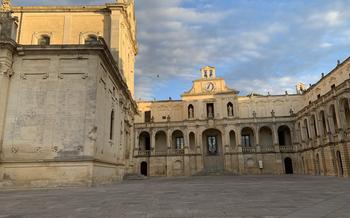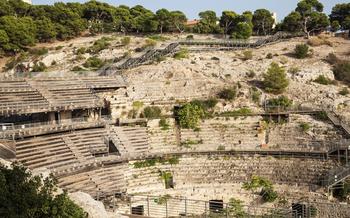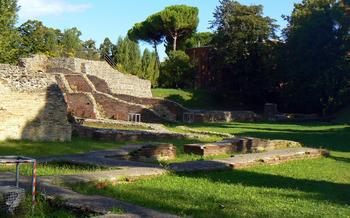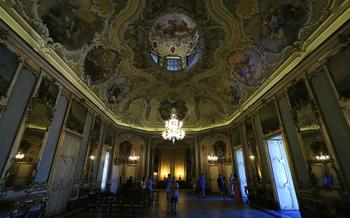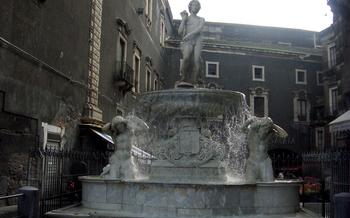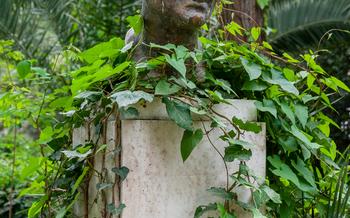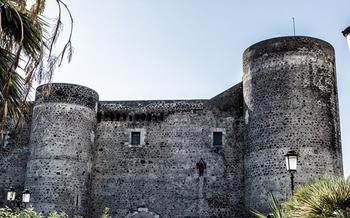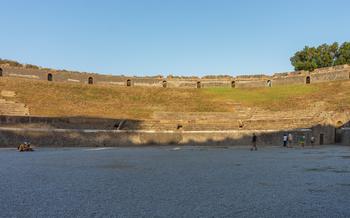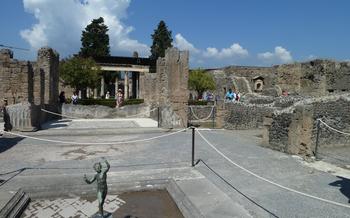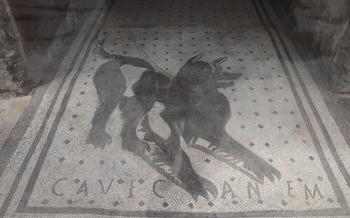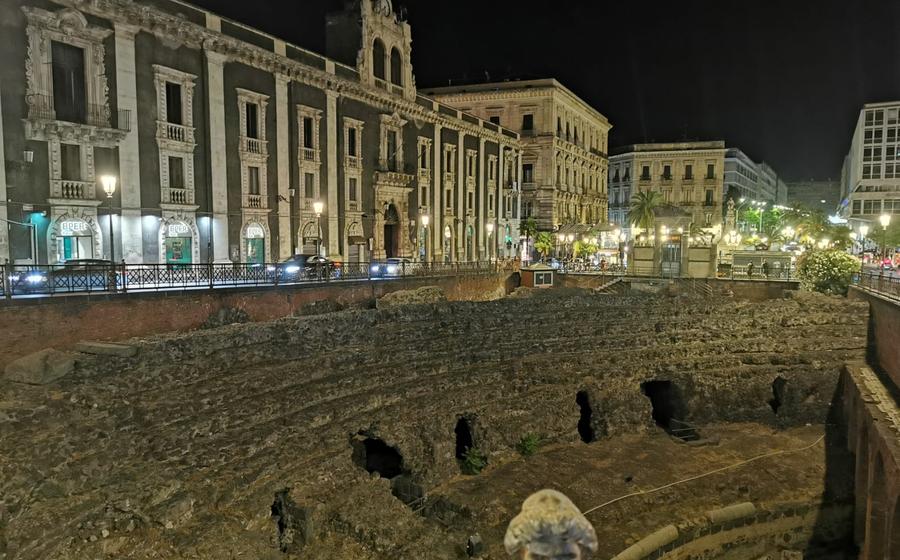
Roman Amphitheater
- Catania's Roman Amphitheater: A Legacy of Spectacle and History
- History and Origin
- Design and Structure
- Gladiatorial Contests
- Public Spectacles
- Restoration and Preservation
- Visiting the Amphitheater
- Exhibitions and Events
- Nearby Attractions
- Historical Context
- Legends and Folklore
- Impact on Tourism
- Virtual Tours and Online Resources
- Educational Programs
Catania's Roman Amphitheater: A Legacy of Spectacle and History
Catania, a vibrant city on the sunny coast of Sicily, boasts a rich tapestry of historical treasures, one of which is its captivating Roman Amphitheater, standing proudly as a testament to the city's ancient heritage. Constructed during the reign of Emperor Hadrian in the 2nd century AD, this magnificent structure once played a vital role in the social and cultural life of the Roman Empire. In its heyday, the amphitheater hosted a variety of spectacles, including gladiatorial contests and public performances, captivating the hearts and minds of the Roman population. Let's embark on a journey through time to explore the depths of Catania's Roman Amphitheater, unraveling its fascinating history and significance.
History and Origin
The Roman Amphitheater of Catania, also known as the Amphitheater of Catania, is a remarkable testament to the legacy of the Roman Empire in Sicily. Built under the rule of Emperor Hadrian, probably in the 2nd century AD, it stands as one of the largest and best-preserved amphitheaters in the region.
Originally constructed for the purpose of hosting gladiatorial contests and public spectacles, the amphitheater was a central venue for entertainment and social gatherings in ancient Catania. It accommodated a significant number of spectators, with estimates ranging from 15,000 to 20,000 seats. The amphitheater's design and architecture showcase the advanced engineering and construction techniques of the Romans.
The materials used in its construction were primarily lava stone and bricks, which were readily available in the region. The amphitheater's elliptical shape and tiered seating arrangement were designed to provide optimal sightlines for spectators, while underground chambers and tunnels allowed for gladiators and animals to enter and exit the arena.
The amphitheater's grandeur and scale reflect the importance of Catania as a prosperous city within the Roman Empire. It served as a hub for entertainment and social interaction, offering a glimpse into the daily lives and cultural practices of the Roman population.
Design and Structure
The Roman Amphitheater in Catania is an impressive structure that showcases the architectural ingenuity of the ancient Romans. Its elliptical shape is a testament to their advanced engineering skills, as it allowed for optimal acoustics and provided clear sightlines for spectators from all angles. The amphitheater's dimensions are staggering, measuring approximately 125 meters in length and 105 meters in width.
The seating arrangement within the amphitheater was meticulously designed to accommodate the needs of different social classes. The lower rows were reserved for the wealthy and influential citizens, while the upper sections were occupied by ordinary citizens. Each section was further divided into blocks, ensuring an organized and efficient seating system.
At the center of the amphitheater lay the stage or arena. This expansive space was the focal point of the gladiatorial contests and public spectacles. Beneath the arena floor lay a complex network of underground chambers and tunnels, providing access for gladiators, animals, and stage machinery. These intricate underground passageways played a crucial role in facilitating the smooth operation of events within the amphitheater.
Gladiatorial Contests
The Roman Amphitheater of Catania was primarily constructed for the purpose of hosting gladiatorial contests, a form of violent entertainment that played a significant role in Roman society. These contests involved trained fighters, known as gladiators, who engaged in combat against each other or against wild animals for the amusement of the spectators.
Types and Training of Gladiators: Gladiators came from diverse backgrounds, including captured prisoners, slaves, and even free men who chose to fight for glory or financial gain. They were rigorously trained in gladiatorial schools, where they learned various combat techniques, weapon handling, and survival skills.
Weapons and Armor: Gladiators were equipped with a variety of weapons, including swords, daggers, spears, nets, and tridents. Their armor consisted of helmets, shields, and protective body gear, designed to offer varying degrees of protection depending on their fighting style.
Rules and Regulations: Gladiatorial contests were governed by a set of rules and regulations. Fights could be to the death or non-lethal, depending on the type of contest and the emperor's or crowd's wishes. The outcome of a fight was determined by the gladiator's skill, strength, and luck, as well as the preferences of the audience.
Significance in Roman Society: Gladiatorial contests held deep significance in Roman culture. They were seen as a form of entertainment, a test of courage and strength, and a way to honor the gods. The contests also served as a means of social control, providing an outlet for aggression and violence within a structured and controlled environment.
Public Spectacles
Beyond gladiatorial contests, the Roman Amphitheater of Catania hosted a diverse array of public spectacles that captivated the Roman population. These spectacles ranged from thrilling animal hunts to awe-inspiring acrobatic performances and captivating theatrical shows.
Animal hunts, known as venationes, were particularly popular among the masses. Exotic animals such as lions, tigers, elephants, and bears were brought into the arena to be hunted by skilled gladiators or condemned criminals. These hunts showcased the prowess of the hunters and provided a sense of danger and excitement for the spectators.
Acrobatic performances, or athletae, displayed incredible feats of strength, agility, and balance. Acrobats performed daring stunts, such as tumbling, jumping, and contorting their bodies into astonishing positions, captivating the audience with their grace and skill.
The amphitheater also served as a stage for theatrical productions, including comedies, tragedies, and mimes. These performances offered a platform for talented actors and playwrights to showcase their works and provide entertainment and cultural enrichment to the Roman citizens.
Public spectacles held in the amphitheater played a crucial role in Roman society, providing a much-needed escape from daily life and a sense of unity among the citizens. They not only served as a form of entertainment but also reinforced social hierarchy, celebrated Roman victories, and promoted cultural values. These spectacles left a lasting legacy on the development of theater and performance arts, contributing to the rich cultural heritage of the Roman Empire.
Restoration and Preservation
The Roman Amphitheater in Catania has undergone significant deterioration over the centuries due to natural disasters, neglect, and the passage of time. The amphitheater's structural integrity was compromised by earthquakes, volcanic eruptions, and erosion, causing damage to its walls, seating tiers, and underground chambers.
In the 19th century, a concerted effort was undertaken to restore and preserve the amphitheater. Archaeological excavations were conducted to uncover buried sections and gain insights into its original form. Structural reinforcements were implemented to stabilize the remaining structures and prevent further collapse. The restoration process aimed to maintain the historical integrity of the site while ensuring its safety for visitors.
Despite these efforts, the amphitheater continues to face challenges in its preservation. Balancing restoration with maintaining the original fabric of the monument requires careful consideration. Conservation measures, such as regular inspections, maintenance, and appropriate restoration techniques, are essential to ensure the amphitheater's long-term preservation for future generations.
Visiting the Amphitheater
The Catania Roman Amphitheater is open to visitors daily from 9:00 AM to 5:00 PM. The entrance fee is €10 for adults, and €6 for students and seniors. Guided tours are available for an additional fee and provide a deeper insight into the history and significance of the amphitheater.
To avoid crowds and fully immerse yourself in the atmosphere of this ancient site, consider visiting early in the morning or late in the afternoon. This will give you the chance to explore the amphitheater at your own pace and take in its grandeur without distractions.
As you enter the amphitheater, take some time to appreciate its impressive dimensions and imagine the roar of the crowd during gladiatorial contests and public spectacles. Walk along the tiered seating arrangement, noting the different sections reserved for various social classes.
Be sure to visit the underground chambers and tunnels, where gladiators and animals prepared for their performances. These spaces offer a glimpse into the behind-the-scenes workings of the amphitheater and provide a unique perspective on its history.
The amphitheater is accessible for visitors with disabilities. Ramps and elevators allow wheelchair users to reach all levels of the seating area, and accessible restrooms are available on-site.
Exhibitions and Events
Within the walls of the Catania Roman Amphitheater lies a museum that serves as a treasure trove of artifacts and insights into its storied past. Here, visitors can delve deeper into the history of the amphitheater, uncovering its secrets and significance through captivating displays and informative exhibits. These exhibits showcase a diverse collection of artifacts, from gladiatorial weapons and armor to pottery and sculptures, providing a tangible connection to the lives and events that once filled this ancient arena.
Beyond the museum, the amphitheater also plays host to a variety of temporary exhibitions and events throughout the year, transforming it into a vibrant cultural hub. From immersive historical reenactments that bring the past to life to captivating concerts that resonate within its ancient walls, these events offer a unique and engaging way to experience the amphitheater's enduring allure.
To make the most of your visit, be sure to check the amphitheater's website or social media pages for information on upcoming events and exhibitions. These events not only enhance your understanding of the amphitheater's history but also provide an opportunity to engage with the local community and immerse yourself in the vibrant cultural scene of Catania.
Nearby Attractions
The Roman Amphitheater is surrounded by a wealth of other historical sites and landmarks that offer visitors a comprehensive glimpse into Catania's rich history and culture. A short walk from the amphitheater, you can explore the Piazza del Duomo, the heart of the city, where you'll find the majestic cathedral, the Palazzo degli Elefanti, the city's town hall, and the Fontana dell'Elefante, a symbol of Catania.
Continue your exploration to the nearby Piazza Stesicoro to admire the ruins of the ancient Roman theater, offering a fascinating glimpse into the city's past. Don't miss the Via Crociferi, renowned for its beautiful Baroque churches, including the Chiesa di San Benedetto and the Chiesa di San Francesco Borgia.
To immerse yourself further in Catania's ancient heritage, visit the Museo Civico di Catania, housing an extensive collection of Greek and Roman artifacts, including sculptures, mosaics, and pottery. The Villa Bellini, a beautiful public garden, offers a tranquil oasis amidst the city's vibrant energy.
Creating a comprehensive itinerary that includes the Roman Amphitheater and these nearby attractions allows you to delve into Catania's multifaceted history and culture. Each site offers unique insights, providing a well-rounded understanding of this captivating city.
After exploring these historical treasures, take a break at one of the many local restaurants or cafes to savor Catania's renowned cuisine. Indulge in a delicious meal of pasta alla Norma, arancini, or a refreshing granita, enjoying the vibrant atmosphere of this lively city.
Historical Context
The Roman Amphitheater in Catania stands as a testament to the power and influence of the Roman Empire. Built during the reign of Emperor Hadrian, it played a crucial role in the social and cultural life of the Roman city of Catina. The amphitheater's grand scale and intricate design reflect the engineering prowess and architectural achievements of the Romans. The gladiatorial contests and public spectacles held within its walls were central to Roman entertainment and served as a means of showcasing imperial authority. The amphitheater's legacy extends beyond its initial purpose, symbolizing the enduring influence of Roman culture and society on the development of Western civilization. It continues to captivate visitors with its historical significance, architectural grandeur, and enduring presence as a reminder of ancient Rome's enduring legacy.
Legends and Folklore
The Roman Amphitheater in Catania has inspired numerous local legends and myths over the centuries, adding to its allure and mystique. These stories, often passed down through generations, provide a glimpse into the rich cultural heritage of the city and its people.
One popular legend tells of a brave gladiator named Catania, who fought with exceptional skill and courage in the arena. He was beloved by the people of Catania, who cheered him on as he faced formidable opponents. In one epic battle, Catania faced a giant and ferocious lion. Despite the odds stacked against him, Catania emerged victorious, slaying the beast with his sword. This heroic act cemented his status as a local legend, and his name became synonymous with strength and bravery.
Another legend speaks of a beautiful woman named Lucia, who was imprisoned within the amphitheater's dungeons. She was destined to be sacrificed during a gladiatorial contest, but a kind-hearted guard helped her escape. They fled the city together, and their love story has become a symbol of hope and resilience in the face of adversity.
These legends and myths have become an integral part of the amphitheater's history, adding depth and character to its ancient walls. They remind visitors that the amphitheater is not merely a relic of the past, but a place where stories of courage, love, and triumph continue to resonate to this day.
Impact on Tourism
The Roman Amphitheater in Catania stands as a testament to the city's rich history and cultural heritage, attracting a steady stream of tourists each year. Its significance as a major tourist attraction cannot be overstated, as it plays a pivotal role in boosting Catania's tourism industry. The amphitheater's unique blend of architectural grandeur, historical significance, and captivating stories draws visitors from around the world, eager to immerse themselves in the remnants of the Roman Empire.
The influx of tourists generated by the amphitheater contributes significantly to the local economy. Visitors often extend their stay in Catania to explore other nearby attractions, sample the city's culinary delights, and soak in the vibrant atmosphere. This increased tourism activity generates revenue for local businesses, including hotels, restaurants, shops, and tour operators, creating employment opportunities and stimulating economic growth.
However, managing the influx of tourists while preserving the historical integrity of the amphitheater presents a delicate balancing act. The sheer volume of visitors can lead to wear and tear on the ancient structure, and it is crucial to implement sustainable tourism practices to mitigate its impact. Limiting the number of visitors allowed inside the amphitheater at any given time, enforcing strict regulations on noise levels and behavior, and providing designated pathways for foot traffic can help minimize damage to the site.
By striking a harmonious balance between tourism development and heritage preservation, Catania can ensure the long-term sustainability of the amphitheater and continue to reap the benefits of being home to this remarkable vestige of the past.
Virtual Tours and Online Resources
Even if you can't visit the Catania Roman Amphitheater in person, you can still experience its grandeur and history through virtual tours and online resources. These virtual tours offer a realistic and immersive experience, allowing you to explore the amphitheater's interior, walk through its ancient corridors, and learn about its fascinating history.
Numerous websites and social media platforms provide in-depth information about the amphitheater's construction, architecture, and significance. You can find historical photographs, videos, and interactive maps that enhance your understanding of this iconic landmark.
By combining virtual tours with online resources, you can gain a comprehensive understanding of the Catania Roman Amphitheater, its role in ancient Roman society, and its enduring legacy as a symbol of architectural prowess and cultural heritage.
Educational Programs
The Roman Amphitheater in Catania offers a variety of educational programs and workshops designed to engage students and visitors of all ages with the history and significance of this ancient monument. These programs provide an immersive and interactive learning experience, allowing participants to explore the amphitheater's various sections, learn about gladiatorial contests and public spectacles, and gain insights into Roman culture and society.
Hands-on activities, such as mock gladiatorial battles and theatrical performances, help bring history to life and make learning fun and engaging. Educational guides and experts lead the programs, offering in-depth knowledge and answering questions from participants.
Through these educational initiatives, the amphitheater serves as a center for learning and cultural exchange, fostering a deeper appreciation for ancient history and its relevance to our contemporary world. Visitors can check the amphitheater's official website or inquire at the ticket office for more information on upcoming programs and workshops.
Participation in educational programs at the Roman Amphitheater offers a unique opportunity to connect with the past, gain valuable knowledge, and create lasting memories. Whether you're a student, a history enthusiast, or simply looking for a fun and educational experience, these programs are an excellent way to explore the amphitheater and its rich history.
